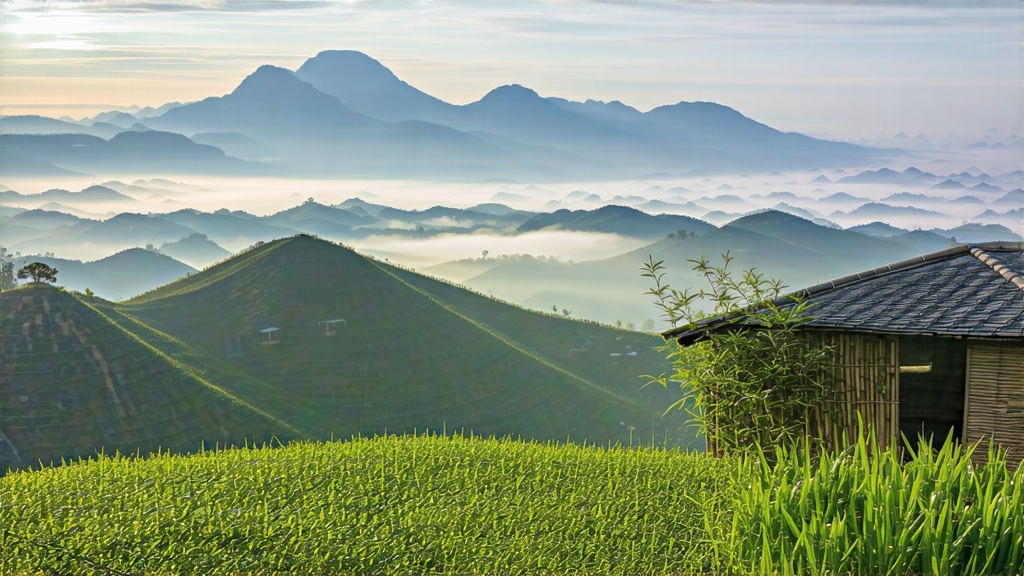
Mengding Huangya, literally “Yellow Bud from Meng Mountain,” is the most revered expression of China’s least-understood tea family: yellow tea. While green tea commands global fame and pu-erh enjoys cult status, yellow tea remains a quiet legend, produced in tiny lots for those who crave the freshness of spring greens wrapped in a mellow, almost creamy warmth. Mengding Huangya is its oldest and most aristocratic representative, born on the mist-capped ridges of Mt. Mengding in Sichuan Province, where torrents of cloud spill over bamboo groves and Buddhist temples have chimed bells since the Han dynasty. International drinkers often mistake it for a delicate green; one sip corrects the error, revealing a silky texture, chestnut-sweet aroma and a finish that lingers like warm honey. This article walks the curious reader through every layer of that experience—history, terroir, craft, brewing and tasting—so that the next cup of Mengding Huangya feels less like a mystery and more like a conversation with Chinese history itself.
Historical scrolls place yellow tea on the imperial tribute list as early as 742 CE, when Tang dynasty court officials accepted bales of “Meng Mountain Yellow Sprout” as tax from Sichuan. Caravans carried the tea north along the ancient Shu Road, over plank bridges nailed to cliffs, to Chang-an, the cosmopolitan capital. Song dynasty emperor Huizong, himself a skilled tea artist, praised the bud’s “jade-yellow down” in his treatise Daguan Chalun. By the Ming, the tea had become so scarce that only the emperor’s private garden on Mengding was allowed to harvest it before the Qingming festival. Legends say that monks sealed the leaves in silver foil and prayed over them for seven nights, believing the mountain’s fog would condense into the cup. When the last dynasty fell in 1911, the recipe almost vanished; farmers switched to faster-paying green teas. It was not until the 1970s that a Sichuan agricultural station rediscovered three ancient shrubs hidden behind a cliff-side temple, grafted their cuttings, and re-created the yellowing technique from oral memory. Today fewer than 2,000 kg of authentic Mengding Huangya reach the market each spring, most of it pre-sold to collectors in Beijing and Shanghai, making every gram that escapes China a small miracle.
The tea belongs to the “bud-yellow” sub-category of yellow tea, meaning it is crafted almost entirely from unopened leaf buds, plucked when they are still reflexed like tiny spears. Standard grade uses one bud and half-open first leaf; tribute grade insists on the bud alone, no longer than 2.5 cm, covered in microscopic hairs that catch the light like pale gold dust. The cultivar is a local Sichuan shrub varietal called “Mengding #9,” selected for its high amino acid content and low tannin, yielding natural sweetness without astringency. The garden sits between 1,000 and 1,400 m on the northern flank of the mountain, where Sichuan’s famous cloud blanket keeps humidity above 85 % and filters sunlight into a soft, diffused glow. Night temperatures drop sharply, slowing leaf growth and concentrating fragrant compounds. Soil is acidic purple sandstone, rich in iron and selenium, which locals credit for the tea’s faint metallic shimmer in the finish.
Crafting Mengding Huangya is a dance of heat, moisture and patience collectively called “sealed yellowing” (men huang). The goal is to remove grassiness while preserving a living green soul, then wrap it in a mellow, nutty aura. Picking begins around March 20, when the Qingming festival approaches and the mountain awakens under peach blossoms. Buds are gathered before seven in the morning, placed in shallow bamboo baskets lined with banana leaves to prevent bruising, then carried downhill on foot within two hours. The first step, “kill-green,” copies green tea: buds are tossed in woks heated to 160 °C for three minutes, deactivating enzymes and fixing the fresh aroma. But here the paths diverge. While green tea is immediately rolled and dried, Huangya is piled while still warm—50 °C internal temperature—into linen sacks the size of pillows. The sacks rest in a cedar-lined chamber kept at 28 °C and 75 % humidity for 48 to 72 hours. During this quiet fermentation the leaf edges oxidize slightly, turning ochre, while the core remains jade.